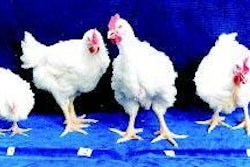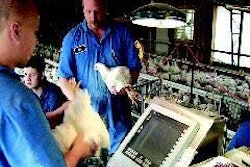Audible sighs of relief greeted the United Kingdom (UK) government’s confirmation of “low path” H7N2 as cause of the latest outbreak of bird flu (Influenza A virus) at Corwen in Conwy, North Wales (24 May 2007).
Though clearly not “high path” H5N1 which “despatched” 160,000 of Bernard Matthews’ turkeys in February, the outbreak still generated hundreds of news items across the world with headlines like “British bird flu not deadly” and “Benign bird flu strikes UK”. But it was deadly enough for the fifteen 22-week old Rhode Island Red hens purchased by the smallholder two weeks before in a market at Macclesfield in the English County of Cheshire 100 km away.
UK has relatively little experience of bird flu irrespective of subtype and pathogenicity (virulence), but poultry farmers in countries like USA with many outbreaks of H7N2 will confirm there is no such thing as “benign” bird flu.
Most influenza A viruses (including H5N1) originating in birds usually occur as “low path” strains. But all have the potential to mutate into “high path” types during course of an outbreak and are viewed as such by poultry industries and governments worldwide. Even nominally “low path” strains of H7N2 may cause “moderate” mortality in poultry as this North Wales experience shows.
In 1994 an H7N2 subtype avian influenza of low pathogenicity was detected in ‘Live Bird Markets’ (LBMs) of the North East United States. H7N2 subsequently circulated in the LBM network, despite efforts to eradicate the virus by market closures and extensive cleaning and disinfection, and went to infect poultry farms up and down the eastern United States.
In 1997/1998 H7N2 appeared in Pennsylvania, causing destruction of 2.5 million birds through a depopulation management strategy before it was brought under control. A H7N2 outbreak in spring and summer 2002 affecting Virginia, West Virginia and North Carolina was originally characterised as “low path”, but before its final containment 20 per cent of the area’s poultry farms were testing positive for H7N2 resulting in the destruction of 4.7 million chickens and turkeys with another 56 million birds put at risk. A 2003 outbreak in Connecticut was potentially devastating too but on this occasion poultry vaccination was used as an alternative to protect the states huge layer flocks. During 1994-2003 between 30 and 808 isolations of H7N2 were made every year (total 3634) in the United States.
The H7N2 subtype is highly transmissible in poultry but transmission to humans is considered rare. And this is simultaneously the most interesting and worrying aspect of the H7N2 UK outbreak, because a relatively large number of people are already testing positive and/or showing flu like symptoms with conjunctivitis.
Four people in UK have already tested positive for H7N2, another 11 are showing symptoms and 36 poultry contacts have been identified and tested so far. One of the infected persons is an 11-year old schoolboy whose classmates and teachers have been offered prophylactic treatment with the anti-viral Tamiflu. One report said two of the positives are in north-west England at least 100km away from Corwen indicating there could be more outbreaks in poultry as yet unidentified. Poultry at another Welsh farm 56 km from Corwen and also with links to the Cheshire market is undergoing tests for H7N2.
Dr Marion Lyons lead consultant in communicable disease control with the National Public Health Service for Wales said “Of the people with conjunctivitis or a flu-like illness, some did not have close contact with infected poultry and for this reason person-to-person contact cannot be ruled out”.
North American strains of H7N2 are nominally “low path” but US scientists have observed several changes in the amino-acid motif at the cleavage site of the H protein of H7N2, suggesting the virus has been moving towards a highly pathogenic form. Mutations that change a virus from “low path” to “high path” during replication in unnatural hosts (e.g. domesticated birds) are well established for a number of subtypes. The H7N3 outbreak in British Colombia, Canada during 2004 which led to destruction of 19 million birds is a classic example.
Poultry industries and governments make little distinction between any H5 and H7 subtypes when it comes to import restrictions, as hard pressed British poultry exporters still reeling after the Bernard Matthews H5N1 outbreak are finding to their cost.


















